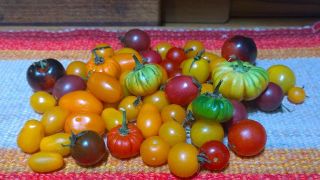If you could see the tomatoes I’ve grown most summers in my shady yard in the Pacific Northwest, you wouldn’t envy me. With the shade of trees and cool summers, we get just enough sun to only tease these large tomatoes about their potential.
Enter the Farmer’s Market.
A fresh summer tomato is like nothing any tomato in February has ever seen.
The candy sweet and mild tang of tomato oozes over every tastebud. The red, green or gold colors of tomato varietals deliver distinct flavors, ranging from delicate to forceful. As the tomato unfolds itself over your tongue, you can feel its silky insides.
The tomato really wants to be eaten. And I’m happy to oblige.
There is a downside to this tantalizing tomato bombshell experience.
Once you’ve had it at it’s freshest, you can never go back. It’s like being Neo in the Matrix. Once you have the red pill – and the truth is revealed – you can never go back.
Hence, my dilemma. I enjoy tomatoes so thoroughly in the summertime so that I can try to get my full-fillment for the months in which ripe tomatoes grace my life. But everything has its season, even gorgeous tomatoes.
And my lesson has been to honor this truth, and to let them go when their time has run out.
Isn’t this a lesson for life?
In modern times, we don’t like honoring the truth of seasons. We’ve become accustomed to over-riding nature’s rhythms. We try to extend the tomatoes well past their prime. We insist that they exist in every grocery store, all year round.
And so, we end up with anemic tomatoes.
You know the kind. The texture is pulpy, mushy, muddy. There is no juice. There is only a ghost of flavor. A wanna-be whose potential was robbed simply by rushing the process.
In the case of anemic tomatoes, one has to pity them. The poor things are dragged into their meager existence. It begins when they are ripped from their Mother Vine, their source of nutrients and flavor. This reminds me of a premature baby losing contact with its umbilical cord, and hence lifeline, too soon in development. But unlike the premie baby, the tomato is not given much of a lifeline when its pulled away in its green state.
What happens next is gas. It is gassed enough so that it become red enough to seduce consumers into a purchase. Then, it receives wax to keep it stable. In other words, it won’t deteriorate quickly. This is good for profits. This helps because the tomato will be air-flown, and/or shipped for hundreds – or maybe thousands – of miles.
On the outside, the premie tomato may look good, but it is truly malnourished when compared to its fully ripened, in season counterparts.
What qualifies as an heirloom tomato?
“The rule of thumb for any kind of heirloom in the seed world is that something has to be at least 50 years old to be an heirloom,” says farmer John Coykendall of Blackberry Farm.
This salad is very fast and easy to make. It taste bests when made a few hours ahead of time. If you have the time for it, you can let it chill in the fridge so that the flavors can mingle and create a delicious dynamic.
Heirloom Tomato Salad:
2-lb heirloom tomatoes – washed and cubed
1/2 cup green or purple onion – chopped finely
1 handful basil leaves – washed and chopped
Dressing:
1 tablespoon olive oil
2 tablespoon balsamic vinegar
1/4 teaspoon honey or maple syrup, more to taste
1/4 teaspoon salt
Toppings:
1/2 cup Feta or Blue cheese crumbles
1/2 cup Pistachios, chopped
Instructions:
- Wash and chop ingredients. Combine them well.
- In a separate bowl, combine dressing ingredients. Pour over tomato salad. Gently toss.
- When it’s time to serve, top with cheese crumbles and chopped pistachios.
How do you enjoy the bounty of the season? Do you eat it right up, or do you preserve? Tell me in the comments below, because I LOVE learning from you!! =-)



